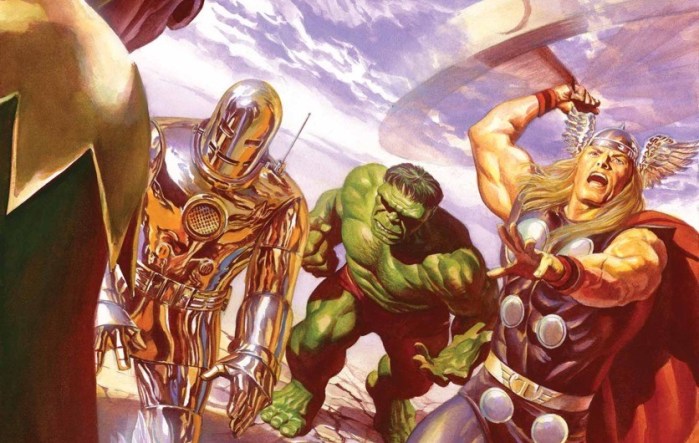“There came a day, a day unlike any other, when Earth’s mightiest heroes found themselves united against a common threat. On that day, the Avengers were born – to fight the foes no single superhero could withstand! Heed the call, then – for now, Avengers Assemble!”
These are the iconic lines which preamble innumerable issues of The Avengers. Of course, that particular day in question (wherein fate intervened to bring together Thor, Iron Man, the Hulk, Ant-man, and the Wasp against one of Loki’s decidedly less nefarious machinations), was hardly unlike any other. There have been as many days like it as there have been incarnations of the Avengers. Years later, it was a supervillain prison breakout at the Raft that brought together the New Avengers. On an alternate Earth designated 1610, it was the military-industrial complex’s answer to the emergence of super-terrorism that lead to the formation of the Ultimates. Most recently in Hickman’s run, the Avengers and Illuminati alike were reestablished upon the later learning of a systemic multiversal collapse.
And now such a day is allegedly here again, fate conspiring to united an “all-new, all different” Avengers. There initial raison d’etre here comes in the form of an overconfident Chituri evidently unfamiliar with Thanos, Galactus, and countless other would-be-conquerors’ who’d been repeatedly repelled by the strongmen of Earth. As far as stakes go, it’s hardly operatic, more Vaudeville than Shakespearean. Tonally, it truly does seem “all-new, all-different” than anything that’s come in the last decade. Simply compare this issue to the opening salvo of Hickman’s previous volume:
“There was nothing. Followed by everything. Swirling, burning specks of creation that circled life-giving suns. And then, we raced to the light. It was a spark that started the fire – a legend that grew in the telling. Some believe it was the moment they rescued Hyperion from a dying universe. Others said it was when the Guard were broken on the dead moon. Many more think it was when Ex Nihilo terraformed Mars, transforming the red planet green. They were all wrong. As it happened before the light. Before the war. Before the fall. It started with two men. One was life… and one was death.
Such set the cadence for a ninety-three issue run across two flagship titles and two major events. Mark Waid, in taking the reigns, opens with the words “You’re a jerk!” They are being shouted by Kamala Khan to Sam Alexander, who also share top billing in the angst-ridden backup story, with promises of more teen drama from the current writer of Archie. This first splash page conveys a message which is reinforced throughout the rest of the issue: nowhere in the promise of “new” and “different” was there any mention of “better,” “as good,” or even “not far worse than before.”
As mentioned in my review of The Ultimates #1, I tend to follow creators instead of characters. Thus, despite disliking nearly every member on both teams save for Nova, I bought The Ultimates based on the involvement of Kenneth Rocafort and Avengers due to Mark Waid. The Ultimates was a genuinely great issue, not merely in the context of my lowered expectations; Avengers, on the other hand, proved that even the esteemed writer of Kingdom Come and Birthright can disappoint on occasion.
In fact, given Waid’s pedigree, one would have expected him to continue Hickman’s DC-ification of the Marvel universe. Like the Justice League, Hickman’s Avengers were modern-day gods; their struggles, their emotions, even they themselves all larger than life. Waid pulls hard in the opposite direction, giving every character the Spider-man treatment. In between the bouts of superheroics they are relatable human beings with pedestrian problems. Sam Wilson deals with social and mainstream media’s constant filtering of reality through the lens of racial politics. Tony Stark is strapped for cash.
The only character such an approach really works for is Sam Alexander, who since his debut has been positioned as the next generation’s Peter Parker. But it comes at the expense of any reader sympathy for Ms. Khan. Their meet-cute is only cute in one direction, that being Sam’s hormone-induced but ultimately harmless bumbling and fumbling for words. Without cause Kamila is immediately curt with him, coming across as a bit of a “Scarlet Witch,” having had more empathy for a rampaging monster than the guy obviously attracted to her. None of which to say their encounter is unrealistic; I’ve met many a Kamala Khan in class and at bars. But that does nothing to endear me to the character Waid is writing.
Adam Kubert is the only artist in the industry whose backgrounds are so much better than his character work, particularly faces, especially considering the face is the detail the eye will naturally focus on. He pencilled several issues of Hickman’s Avengers as well, and of all the incredible talent on that run it is surprising that Joe Kubert’s eldest was the one asked to illustrate Marvel’s flagship title. Overall, his art in this issue is lukewarm; neither reason to buy it nor reason not to.
Which is another way of saying Kubert’s art doesn’t save Waid’s writing, which itself doesn’t save the eclectic roster of characters Marvel seems dead set on convincing readers are destined to become as iconic as Steve Rogers and Peter Parker. Perhaps in the decades hence, after other writers have explored these characters, that may prove true. But if this opening issue is any indication, it won’t be Mark Waid or this run to accomplish such a task.
Don’t heed the call. These Avengers don’t need to assemble.
2.75/10




Pingback: Squadron Supreme #2 | The Hub City Review